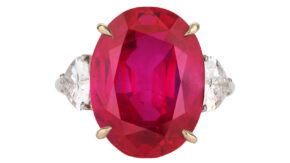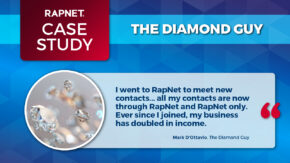China’s crackdown on conspicuous consumption is dampening diamond demand there, and this has consequences for the rest of the global market, Rapaport Group Chairman Martin Rapaport told diamantaires in Los Angeles last week.
Rapaport was the keynote speaker at a gathering of the Diamond Club West Coast, where he addressed issues including synthetic-diamond competition, the shifting balance of global political power, and the importance of what diamonds symbolize to the consumer.
Diamond demand is down 50%, he reported. Besides the constricting Chinese market — which he declared was “finished, kaput” factors impacting diamond prices include US politics and the aftermath of Covid-19. However, “the biggest force reducing global natural diamond demand is synthetics,” he maintained.
Despite their short-term appeal, Rapaport predicted, synthetics will eventually “go the way of cubic zirconia. It’s going to go the way of moissanite.” There will be “a bifurcation of markets,” with “people that don’t have money on one side, enjoying synthetic-diamond jewelry…maybe having aspirational demand: One day I’m going to get a real diamond.”
An impending influx of inherited wealth will help make that possible, he added. As older generations die and pass down some $72 trillion — as well as jewelry — to Millennials and Gen Z, there will be both buying and selling opportunities for the diamond industry.
But it’s not just about marketing, he stressed. “It’s the psychological, mental vibe that the person gets by buying and giving a diamond to someone. That’s what the business is really about.”
Here are few of the other points Rapaport raised in his address:
- With the Chinese market increasingly out of the picture, Dubai is “the new Hong Kong” when it comes to diamond trading.
- India’s import tax is leading to a trade imbalance with the US. “In order to import diamonds into the second-largest diamond market in the world, which is India, you have to pay a 7.5% tax,” Rapaport explained. “But for Indians to come and sell goods in America, [there’s] no tax, no company, no nothing…. Where is the leadership of the industry on this?”
- The affordability of synthetic diamonds has cheapened the value of natural diamonds in consumers’ eyes. The way to restore that value is to market the idea of natural diamonds to people with the money to buy and appreciate them — “real people, real money, real diamonds.”
Image: Martin Rapaport. (The Jewelers 24 Karat Club of Southern California)
Stay up to date by signing up for our diamond and jewelry industry news and analysis.



